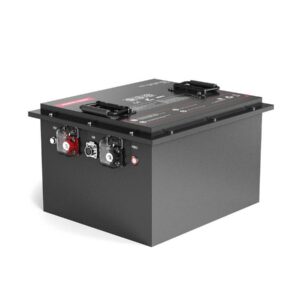
Do deep cycle batteries have a CCA rating?
Deep cycle batteries don’t have Cold Cranking Amp (CCA) ratings, as they’re engineered for prolonged energy discharge rather than short bursts. These batteries prioritize capacity (Ah) and cycle life, making them ideal for RVs, marine systems, and solar storage. CCA metrics apply only to starter batteries designed for rapid high-current discharges to ignite engines.
Are Duracell Car Batteries a Good Choice for Your Vehicle?
Why isn’t CCA applicable to deep cycle batteries?
CCA measures a battery’s 30-second power output at 0°F (-18°C), a demand irrelevant to deep cycle use cases. Deep cycle batteries focus on stable energy release over hours, with thicker plates and denser active materials. For instance, a 100Ah marine battery can discharge 5A for 20 hours, whereas a 700CCA car battery delivers 700A in 30 seconds before recharging.

Technically, deep cycle designs sacrifice surface area for plate durability, reducing instantaneous current capacity. A 12V lead-acid deep cycle might manage 200-400A briefly, but sustained draws above 50A risk voltage sag. Pro Tip: Never substitute deep cycle batteries for engine starting—repeated high-current pulls degrade their thicker plates faster. Think of it like using a marathon runner for sprinting: possible, but inefficient and harmful long-term.
What differentiates deep cycle from starter batteries?
Starter batteries use thin, porous plates maximizing surface area for quick discharges, while deep cycle variants employ thick, solid plates for cyclic endurance. A typical car battery lasts 3-5 years with 20,000 engine starts but fails if drained below 50%. In contrast, lithium deep cycle batteries (e.g., LiFePO4) tolerate 80% depth-of-discharge (DoD) for 4,000+ cycles.
Beyond chemistry, internal resistance varies significantly. Starter batteries have 2-5mΩ resistance for rapid current flow, whereas deep cycle units range from 5-20mΩ to limit heat buildup during sustained loads. For example, Trojan’s T-105 flooded lead-acid battery provides 225Ah but just 875MCA (Marine Cranking Amps), highlighting the capacity/cranking trade-off. Pro Tip: Hybrid AGM batteries like Optima BlueTop offer compromised CCA (800A) and moderate cycle life (300 cycles at 50% DoD) for dual-purpose applications.
| Parameter | Starter Battery | Deep Cycle |
|---|---|---|
| Plate Thickness | 1.2-1.5mm | 2.4-3.0mm |
| Typical Cycles | ~500 | 1,000-4,000+ |
| Peak Current | 500-1000A | 50-200A |
How are deep cycle batteries rated instead of CCA?
Manufacturers use amp-hours (Ah), reserve capacity (RC), and cycle life as key metrics. A 200Ah lithium battery at 12V stores 2.4kWh, while RC indicates minutes at 25A discharge before hitting 10.5V. Battle Born’s 100Ah LiFePO4, for instance, guarantees 3,000-5,000 cycles at 100% DoD—equivalent to 8-14 years of daily use.
But what about peak loads? While CCA is absent, some brands publish maximum continuous current (e.g., 100A for Renogy’s 100Ah gel battery) or pulse ratings (200A for 5 seconds). Transitioning to real-world applications, a 30Ah AGM battery might power a trolling motor at 30A for 1 hour, whereas trying to crank a V8 engine would instantly trigger low-voltage cutoffs. Pro Tip: Size deep cycle banks to keep discharge rates below C/5 (Ah capacity ÷ 5) for optimal longevity.
Are there exceptions with dual-purpose batteries?
Some marine/RV batteries blend moderate CCA and deep cycle traits. Mercury’s Dual AGM series offers 750MCA and 160Ah, but cycle life drops to 500 at 50% DoD—half that of pure deep cycle models. These hybrids use intermediate plate thickness (1.8-2.0mm) and advanced pasting techniques to balance surface area and durability.
Practically speaking, dual-purpose units work well for boats needing occasional engine starts and accessory power. However, they’re costlier than specialized batteries—a 31DCMSDC DieHard marine battery costs $250 versus $180 for a deep cycle equivalent. For example, using a VMAX SLR125 (125Ah, 800CCA) in a sailboat’s house bank provides emergency cranking but reduces daily cycling efficiency by 15-20% compared to non-hybrid models.
| Battery Type | CCA/MCA | Ah Capacity |
|---|---|---|
| Dual-Purpose | 600-900A | 75-200Ah |
| Pure Deep Cycle | 0-300A | 50-400Ah |
What happens if you misuse deep cycle batteries for cranking?
Repeated high-current draws cause plate warping and active material shedding, slashing capacity by 40% within 50 cycles. Lead-acid batteries suffer most—testing shows a 6V golf cart battery rated for 2,000 cycles at 20% DoD fails after just 30 starts of a small engine.
Lithium options fare better due to resilient LiFePO4 chemistry, but BMS protections usually limit output to 100-200A. Imagine trying to jumpstart a truck with a 100Ah lithium bank: the BMS would trip within seconds, leaving you stranded. Pro Tip: Always install a dedicated starter battery if your system requires cranking—deep cycle savings vanish after two premature replacements.
What Is the Best Battery for a Diesel Pickup Truck?
Battery Expert Insight
FAQs
Can I use a deep cycle battery in my car temporarily?
Not advised—deep cycle batteries lack the thin plates needed for repeated high-current bursts. Temporary use might work, but expect shortened battery life and potential starting failures in cold weather.
What’s the equivalent of CCA for deep cycle?
Look for “maximum continuous discharge current” (e.g., 100A) or “5-second pulse rating” in specs. These indicate safe load thresholds without plate damage.
Do lithium deep cycle batteries handle cold better?
LiFePO4 performs better than lead-acid in cold but still needs heating below -4°F (-20°C). Their BMS typically limits charging under freezing temps to prevent lithium plating.
